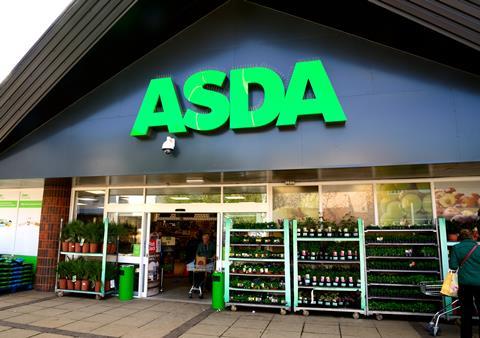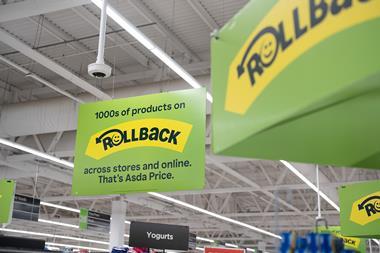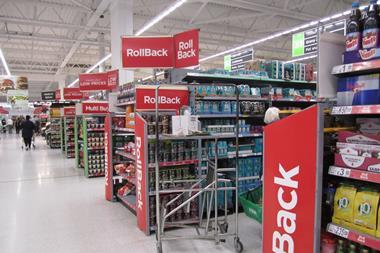
Asda chairman Allan Leighton must fix the operational issues plaguing the chain in the coming months to avoid any further declines in its credit rating, according to Moody’s.
The credit ratings agency warned today that Asda was in danger of falling behind Morrisons, which continues to improve its performance under CEO Rami Baitiéh.
By contrast, Asda has been without a permanent CEO since Roger Burnley left the business in 2021, with sales in freefall and market share dwindling.
This week, Kantar revealed Asda sales sank 5.2% in the 12 weeks to 28 January – the only major grocer to post a decline over the period.
Morrisons’ rating remains slightly worse than Asda’s, with the former listed as B2 and the latter as B1, which are both classed as a speculative, high credit risk. However, Moody’s said Morrisons’ rating would continue to improve thanks to the recent reduction in debt to below £4bn – down from £5.6bn when Clayton Dubilier & Rice took over – and renewed operating momentum.
Asda saw a ratings upgrade in April last year from B2, but since then operational difficulties have weakened its credit quality, “with the prospect it could decline further” if it does not restore revenue growth, Moody’s warned.
“In tandem with battling for market share in a highly competitive market, Asda has faced substantial operational hurdles, related to customer service, store experience and product availability,” the ratings agency added.
Leighton, an Asda veteran, is fighting hard to turn around the group’s fortunes since replacing Stuart Rose as chairman last year, vowing to “restore Asda’s DNA”. Last week, he introduced a swathe of price cuts as part of a Rollback campaign fronted by Joe Wicks to make Asda’s entire product range cheaper than all other full range supermarkets within the next two years.
But Moody’s flagged the operating performance at Asda had been weaker than expected, with deleveraging slower than the agency forecast in April.
It estimated Asda’s Moody’s-adjusted gross leverage to be about 5.7x for the 12 months ended September 2024, and expected the debt/EBITDA leverage ratio to hover around 5.5x through the end of 2025 as a result of a revised adjusted EBITDA forecast of £1.5bn, down from £1.7bn. Asda’s cash generation was also weaker than expectations in 2024.
Debt at the group remained at about £4.7bn, up slightly on the £4.4bn in the wake of the leveraged buyout by TDR and the Issa brothers in 2021.
Moody’s noted acquisitions of convenience stores from Co-op and the integration of EG Group’s UK forecourt operation was partly responsible for unchanged debt levels and said the separation from Walmart had been complex, with a potential payment of at least £900m due to the group’s former US owner in 2028.
“This situation has underscored the need for Asda to enhance its governance quality and maintain continuity,” Moody’s added. “The Asda team still needs to demonstrate a strong execution track record in addressing all operational issues effectively.”
Moody’s expected Asda to pay the Walmart liability using its high levels of cash generation but warned the leverage ration could deteriorate if it decided to take on extra debt to fully or partially refinance the obligation.
An Asda spokesman told The Grocer in response to the note from Moody’s: “The report highlights that Asda is a larger and more diverse business than Morrisons, with a notably higher credit rating and stronger free cashflow generation.
“We know there are some areas where we need to improve to deliver a consistent experience for our customers and we are addressing these as a priority. This includes putting more resources into our stores and launching Rollback and Asda Price to reduce prices across our entire product range.”
Asda also completed a £3.2bn refinancing in May last year, pushing its near-term debt maturities into the next decade.
Moody’s noted Asda had actively addressed some issues recently, including raising staff pay to boost hours in store and improve customer perception, as well as enhancing its price competitiveness.
Project Future had “consumed considerable management attention” and as of September 2024 had cost more than £800m in operational and capital expenditure, Moody’s said, with a further £150m estimate for 2025 as the project concludes.
“The wrap-up of Project Future, combined with management’s efforts to refine its customer rewards programme, boost product availability and upgrade the overall customer experience while keeping prices low could support stabilising its market share,” the ratings agency added. “However, significant execution risks remain at this stage.”



















No comments yet